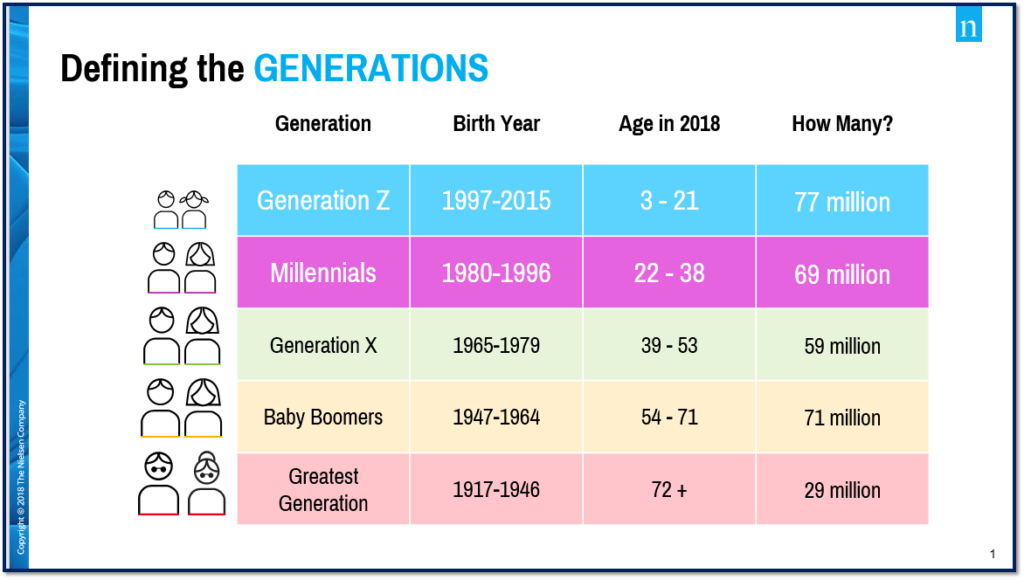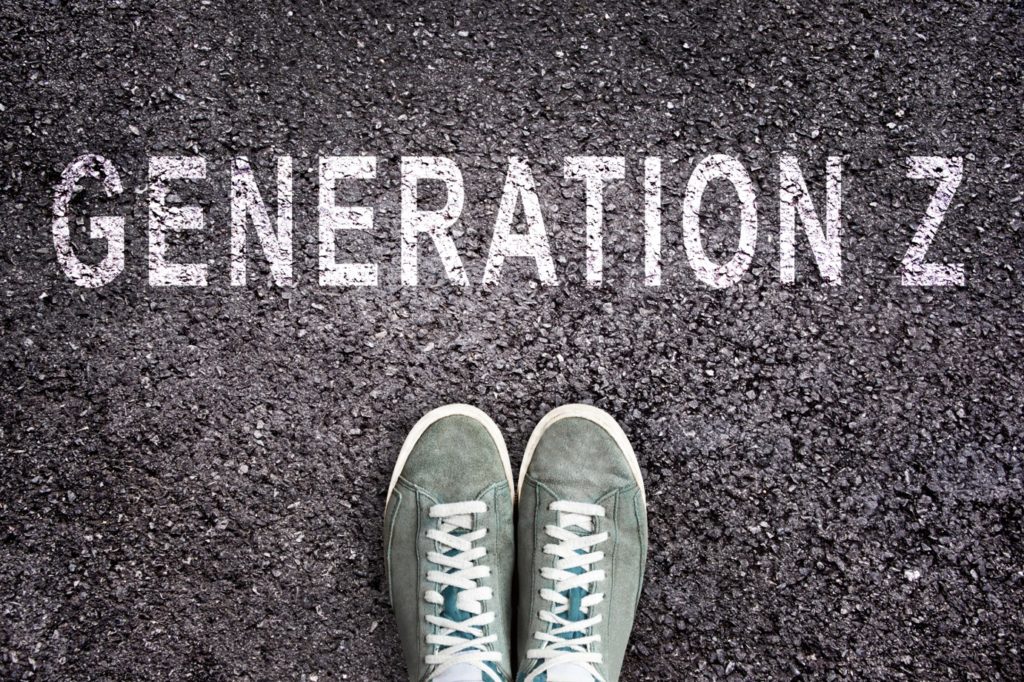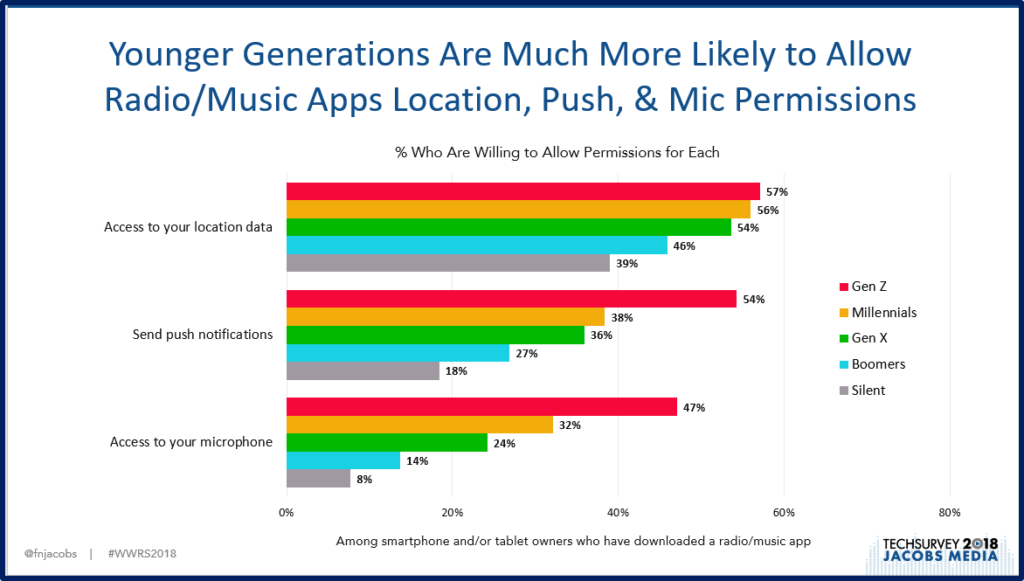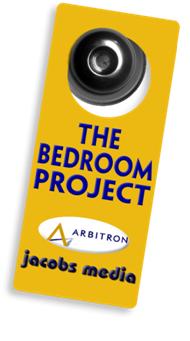
I was never a math whiz, despite our company’s association with research, our many Techsurveys, and my occasional claims that I’m a “data whisperer.” But it doesn’t take a genius to look at the above chart and come to the quick conclusion there are even more changes just around the corner. It was presented by Nielsen’s talented VP, Audience Insights, Jon Miller, at Worldwide Radio Summit last week in Hollywood.
Take it from this aging Boomer, the bump in population among Gen Z should cause everyone in radio to look up from their Starbucks and oatmeal this morning and pay attention. For the last several years, we’ve been actively debating the power and import of Millennials. We often speak about them as kids, but the fact is, many have already been in the U.S. workforce well more than a decade.
In the meantime, their younger siblings (and in many cases, their children)—known as Gen Z—have already eclipsed Millennials in size, and perhaps soon, influence and societal impact.
For radio, this isn’t a good omen. As CMG’s Tim Clarke lamented at WWRS, radio execs often claim their expertise by quoting a 12-year old niece, rather than immersing themselves into new digital, social, and mobile platforms. And he’s right, of course. You can’t talk about technology—it has to become a vital part of your life—personally and professionally.
It’s also a truism that it’s not about anecdotes, but in the hard data that underscores how the U.S. population is changing fast. That’s why Techsurvey continues to mine Generation Z, despite the difficulty in finding them in radio station databases. Still, Techsurvey 2018 aggregated a sample of more than 650 of them who have something to do with radio. They only represent 1% of the overall sample, but they spoke with a big voice.
We’ve seen the phenomenon in stories like the Parkland teens who are trying to change the nation’s discourse about guns. On the other end of the spectrum, watch aging representatives of Congress try to ask intelligent and probing questions of Mark Zuckerberg a few weeks back. Their lack of understanding of social media and web basics underscores the technical generation gap—or call it an abyss—that separates youth from adults.
This hits home for me in an editorial in Adweek by 23 year-old Dari Kreitenberg earlier this month. A proud member of Gen Z, Dari goes off on Congress and older generations for their lack of understanding of today’s generation of youth. Here’s how she sees it from her perch:
“While memes of out-of-touch senators and op-eds from baby boomers to millennials expressing their opinions about privacy in the digital age are everywhere, it seems like we’re missing the opinions of those who were born in the digital age and grew up with social media: Generation Z.”
Radio’s much uttered “93% Argument” aside, Nielsen data already shows that while the vast majority of Millennials still cume broadcast radio every week, their usage numbers are eroding. Thinking about Gen Z, you have the right to start this week on a note of nausea.
But there are opportunities with Gen Z—if radio actually decided to research them, listen to them, and pay attention to them. When was the last time a broadcast radio-commissioned perceptual study included 12-17 year-olds (or younger)? The answer is never.
Many laughed at Arbitron when they originally went to 6+ measurement. It wasn’t funny—it was prescient. Radio operators may ignore these numbers, jumping to the 25-54 page, but the reality is that radio’s future may very well be dependent on its ability to connect with the nation’s kids, lest the industry goes the way of print.

All of a sudden, Facebook (and other high-profile hacks and breaches) are scaring older generations to their core. Privacy issues, exacerbated by these new data horror stories, are ominous and even terrifying.
Unless, that is, you’re a member of Generation Z.
As young Dari Kreitenberg cuts to the quick:
“As a Gen Zer, who was raised in an ever-changing digitized world, I can honestly say that many people my age have a different notion of privacy, the inner workings of Facebook’s privacy policy and its use of our information for targeted ads. We are a generation that covets immediacy, accessibility and instant gratification. Even more so, based off the way we live our lives, I think it’s safe to say that we believe that by virtue of using these platforms, we relinquished our right to privacy long ago.”
She reminds us a key to these permissions is the ability to control who sees their information—and for what duration (yes, think Snapchat).
Gen Z simply profiles differently from the rest of us—including even Millennials. When it comes to their use of mobile, social, and other platforms, they’re often in their own zone. We saw this in a new series of questions in Techsurvey 2018 where we measured “permissions” among our entire sample—for location-based, push notifications, and mobile phone microphone access.
Looking at this chart, it’s easy to see that Gen Z leads all other groups in their openness to these various online permissions. As Dari notes in her op-ed:
“As tech-natives, we are comfortable sharing personal moments through media. However, we still prefer a greater sense of control over who sees our data and for how long.”

My intention is not to start a 4-alarm fire over Generation Z. But my admonition to Xers and my fellow Boomers in radio is to stop telling stories about your children, grandchildren, nieces, and nephews. Instead, research them, observe them, listen to them, and start thinking about how a new cohort of Americans is already consuming, accessing, and enjoying media content.
I’ve heard too many of my aging colleagues shrug their shoulders and lament that the dilemma of future generations of radio listeners will be someone else’s problem. By then, they’ll be on the golf course, playing out what they hope will be a peaceful, prosperous, and happy retirement.
For their sakes, I hope so, too.
But for the sakes of their younger radio counterparts stuck with figuring out this demographic Rubik’s Cube, putting financial and human resources toward addressing what is an obvious demographic game-changer for an aging medium is of paramount importance—now.
 This is not a new issue for radio. Back in the year 2000—yes, 18 years ago—I put together a presentation for an NAB convention titled “Your 14 year-old thinks radio sucks.” Seven years later, Arbitron partnered with us to produce “The Bedroom Project,” radio’s first ethnographic study—an eye-opening series of videos that showed the industry how America’s youth were engaging with new technology, while radio was mostly an afterthought they checked out in their cars. Note this was before the advent of the “connected car.” Even back in 2007, you could easily spot the drift away from broadcast radio.
This is not a new issue for radio. Back in the year 2000—yes, 18 years ago—I put together a presentation for an NAB convention titled “Your 14 year-old thinks radio sucks.” Seven years later, Arbitron partnered with us to produce “The Bedroom Project,” radio’s first ethnographic study—an eye-opening series of videos that showed the industry how America’s youth were engaging with new technology, while radio was mostly an afterthought they checked out in their cars. Note this was before the advent of the “connected car.” Even back in 2007, you could easily spot the drift away from broadcast radio.
Sadly, nothing’s changed, and now we’re faced with a demographic deluge of adolescents who are already proving to be major consumers, as well as thought leaders as our society and culture are rocked by change.
I am confident we Boomers will solve our Social Security challenge in order to ensure we all receive our payouts.
It’s also our obligation to fix this Gen Z thing—or at least head down that road while it’s still open to us. Perhaps some radio companies are being  manned by executives who are focused on Q2 performance. But many others are headed up by the children of radio visionaries who paved the way back in the ’60s and ’70s. They are today’s radio leaders tasked with solving this challenging problem—and industry groups should enthusiastically work closely with them to begin the process of figuring it out.
manned by executives who are focused on Q2 performance. But many others are headed up by the children of radio visionaries who paved the way back in the ’60s and ’70s. They are today’s radio leaders tasked with solving this challenging problem—and industry groups should enthusiastically work closely with them to begin the process of figuring it out.
The numbers don’t lie. Add the Millennials and the Gen Z groups together, and you’ve got roughly half of the U.S. population right now today.
Radio needs a “Z Strategy.”
- 5 Lessons For Radio From The Apple Watch - May 5, 2025
- DJs And Baristas: Can They Save Their Companies? - May 2, 2025
- Radio’s New Audience Equation: Z Over Y = Trouble - May 1, 2025




We have changed the way radio is measured (PPM).
So, nothing to worry about.
When you pay one Gen Z to listen to radio they will. Then manipulate the numbers to suggest the ONE represents so many others.
If that ONE doesn’t listen to the radio as Neilson would like, you change the sample to ONE that will and…Viola…Radio thrives behind a Bullshit sample that we can in turn sell to Advertisers.
Brilliant.
Well, Snappy, sounds like you’re not a fan of Nielsen. Maybe radio starts making content for Gen Z, THEN get pissed at Nielsen for being unable to measure them.
Simple thoughts from somebody named Snappy.
The idea behind the blog is to take that Good Magic that radio once cast upon it’s captive audience and discover new ways to attracts Gen Z naturally. Mold the Model, don’t let the Model Mold.
Fred,
Let me Justify what I said about Neilson.
It has made it impossible to measure who is listening based on PPM.
The sample is smaller and tainted by the Audible quality of the code that is either being boosted or not on stations that do better playing music than talk.
We don’t program for an audience we program for PPM. (EX. Let’s play music beds under talk because the PPM code is easier to be picked up by the devices that happen to be listening while resting on the humans hip)
Neilson determines who it wants to hold meters based on how well they follow the rules of listening according to them. It’s not a natural sampling, it’s HORSE shit.
I can’t be the Lone Sailor on this. Even though I seem Combatant, I just wanted Neilson’s Promises Fulfilled of a better more accurate sampling. My Boy Jack, who is Gen Z, feels the same.
Instilled Regard,
Snap
Snappy, thanks for the clarification. And I know many broadcasters feel your pain. Audience measurement is imperfect and often frustrating. You’re not the lone sailor on this, to be sure, but I’m not sure it’s just a ratings issue. Radio companies have to look at the entire playiing field – not just the 25-54 section – and decide what their future is all about. I would love to see some genuine attempts at appealing to young kids – before 18 – as well as AARP members above 60. If, at the point, Nielsen couldn’t measure these stations well, then radio has a reason to bitch. But until there’s a willingness to serve unserved audiences, we’re just not going to ever know.
Vino, we first have to decide – as an industry – whether any of this matters to the health and profitability of the industry. I believe it does, but I’m not sure that some of radio’s movers and shakers see it that way. As someone asked me earlier this morning after reading the post, what’s the ROI on survival? That’s a good question. Thanks for the comment.
By reading this, I’m not sure if you’re suggesting we tailor content to younger listeners or find easier ways for them to ingest our current programming…
I believe that we don’t need to research how to change our content to reach younger listeners. It’s great in theory, but can you imagine Jay Leno playing Jimmy Fallon’s singing games or skits with Justin Timberlake? Chasing an audience often doesn’t please your intended new crowd & turns off your original listeners because you lost what they loved.
In my opinion, what we should be doing is focusing on researching technologies that will make the medium more appealing for young listeners AND entertainers. By investing in new tech and bringing radio into an audio/visual/VR/AI world, we make radio cool again and your 14 year old stops thinking radio sucks – because it’s more than radio at that point, it’s an enhanced experience.
The Kentucky Derby has run every year since 1875, but where did I watch it? On my phone. They didn’t chase the audience by setting the jockeys on fire, they just delivered it to me in a new technology.
By doing this, we immediately lower our audience’s age without changing content & inspire the Jimmy Fallons of the future. The truth is that new generation will view this form of storytelling very differently and there will be a new class of broadcasters to take our place. I’d rather inspire them then rage against the inevitable.
The speed bump in this conversation is changing the mindset of the industry to evolve beyond a broadcast tower & call letters into WiFi & a URL. But without doing so, there’s no chance of getting this generation on board.
Change your content all you want, chase research & talk to a million kids. But if you can’t deliver your product using technologies they know/trust, you might as well give up the race.
As someone passionate about tech AND radio, the issue becomes ratings.
On one hand, if I dedicate my time/energy into new technologies, I’m hurting myself because I’m only rated on one single method of delivery – the terrestrial signal.
On the other hand, if I only focus on winning the PPM game (earlier commenters nailed it), I further isolate myself from young listeners by not evolving technologically.
Until we collectively find value in these new, exciting ways to deliver our content, we’re doomed. We must inspire younger people to take leading roles in our industry and support them when they make decisions out of our comfort zone.
Don’t just target them as listeners. Target them as leaders.
You make some great points here. Research like our Techsurveys do a serviceable job of outlining the best pathways for reaching different generations. And many broadcasters are involved in digital delivery. I sit in umpteen research meetings and presentations every year, and I can tell you that broadcasters simply don’t have the stomach to targets teens (or AARP members).
I’m a firm believer the industry has to create programming to suit new audiences – not market existing products to them. In the case of Gen Z (and Millennials, too), the writing is on the wall. Those statistics indicate change is in the air, yet radio continues to provide the same 10 formats.
Thanks for the comments.
I don’t believe that it has ever been the industry’s job to create programming in the first place.
It’s our job to build a space so that creative people can thrive. In return, we all thrive. It’s should be the industry’s goal to incubate talent, encourage innovation and have open discussions about change. We should be trusting our current hosts and keeping an eye out for hungry up-and-comers who view radio with enthusiasm.
The problem is that the industry views ITSELF as dying. Most companies are consolidating jobs, giving too many tasks to overworked employees and are so desperate to make a sale, OFTEN at programming’s expense and OFTEN looping programming out of those decisions until they’ve sold content away. Therefore, there’s no room to encourage younger broadcasters to enter the industry, and no creative space for them to play. And when we DO get attention from a new generation of entertainers, we reek of desperation.
For the record, in these discussions, I’m not referring to music formats or spinning records. I believe we’ve reached the point of no return when it comes to ingesting music. The future is on-demand and we simply can’t deliver that. I don’t ever see a destiny that involves radio as a primary music delivery platform. I believe those days are coming to an end.
What we CAN do is the only thing LEFT to do – double down on the content that CAN’T be streamed on Spotify, Amazon or Apple Music…and that’s human talent. Companies like Netflix have benefited by shifting their focus from pushing other people’s projects (big studio movies) and doubling down on ORIGINAL content. Hulu, Amazon & even Facebook are doing the same – creating a space for talent to feel supported and free.
When we take our cues from innovative companies like these and laser-focus our attention on what CAN’T be duplicated, we will regain an edge. Anybody can play the new Taylor Swift song. In fact, the audience can do the exact same thing by saying Alexa’s name. What makes us different? The human connection with the listening public. If we don’t collectively believe in that connection, we shouldn’t be here.
As an industry, if we create an atmosphere where talent feels supported, deliver content in new, exciting ways and finally put some energy into hiring younger decision-makers, a new group of entertainers will be DRAWN TO radio. Once they’re here, THEY will create the programming for Gen Z, because that’s what supported, creative people do.